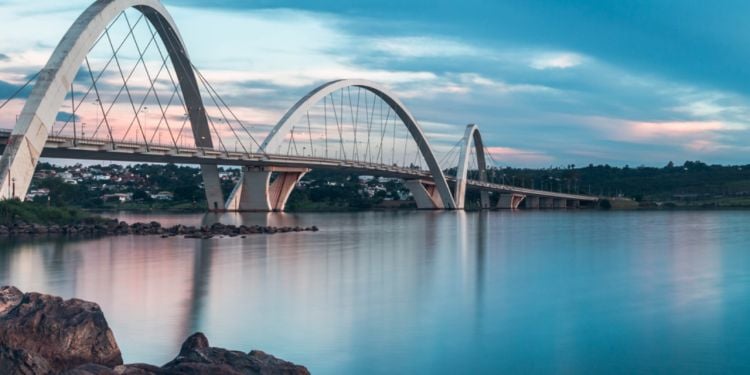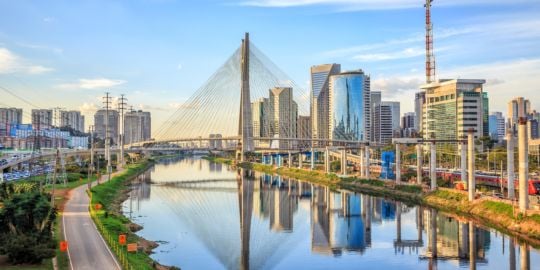Accommodation in Brasilia

Brasilia, the country's federal capital, is home to many highly-paid government employees and foreign nationals. In this white-collar economy, high salaries are one factor driving up the price of accommodation, which is rated to be the third-highest in the country. Still, with a population of over 4.6 million, the city does offer opportunities for accommodation. Before beginning your search for accommodation in Brasília, first read Expat.com's Accommodation in Brazil section.
Living in Brasília
Brasília is perhaps unique among major Brazilian cities in that it was planned. Certain sectors were designated for specific activities, such as banking, hospitality, and governmental activity. The city is laid out in the shape of a cross (most say it represents an airplane), with the east-west axis (“wings”') for business and governmental activities, and the north-south axis designated as residential.
There's also a manmade lake in the middle of Brasilia called the Paranoa. What's interesting to note is that it was originally put in to held humidity levels in the city, as the climate is very dry there. But today, it has an even bigger purpose than raising the humidity. It's also great for water sports, which has attracted businesses like restaurants and private clubs along the lake.
The different residential areas are principally for the middle and upper classes, which include a large number of expatriates. Poorer neighborhoods and even entire towns, sometimes termed antibrasilias, have sprung up nearby to house Brasília's working-class employees. These areas are much less desirable places in which to live.
Some neighborhoods contain apartment buildings, while others are restricted to houses of no more than three stories. In general, single-family homes are quite expensive, so apartments are a better option for most. Apartment buildings also have the advantage of generally being more secure.
Neighborhoods in Brasília
The Lago Sul, Lago Norte, and Parkway bairros (city districts) are very nice, but may be outside the price range of most, with mansions ranging from several hundred thousand dollars to the millions.
Nice and more realistic areas for most are Águas Claras, Asa Sul, Asa Norte, and Sudoeste. Of these, Águas Claras, to the north, may be the cheapest, as it lies a bit further out from the city center. However, it's served by the metro. Águas Claras is largely self-contained, with stores, malls, and restaurants.
Asa Sul and Asa Norte (literally “South Wing” and “North Wing”) are easy to navigate, as streets are numbered. Nicer apartments in these areas can be pricey, but smaller apartments above businesses are less so. Public schools are good, and there are many parks. Asa Sul is served by the metro, but Asa Norte is not.
Another area to consider is Sudoeste (Southwest). This area was a later addition to Brasília, dating only from 1989. It has many green spaces and bike paths. However, real estate prices are more expensive here than in the previously mentioned areas.
Good to know:
As Brasília wasn't built until the end of the 1950s, most construction there is relatively recent.
Below is some more detail about Brasilia's neighborhoods.
Asa Sul (South Wing)
If you'd like to rent an apartment, then you're better off in Asa Sul. In fact, it was listed by UNESCO as a World Heritage Site back in 1987, so it's truly a sight to behold. This is one of the most populated neighborhoods in Plano Piloto, so if you like to be surrounded by people, you'll like it here.
Here, the apartments look very uniform from the outside, as they're all pretty modern. They're made of concrete, but don't let that get you down. Inside, the apartments are very nice and light, which makes them pleasant to live in. In addition, you might have access to a cobertura (rooftop area). This is usually shared with the other tenants, but you'll find some nice amenities, such as swimming pools. They might also be decorated with nice plants.
In general, Asa Sul is the older part but is more developed. Within this area (and Asa Norte), you'll get superquadras, which is a division of the wing into residential and commercial areas. Typically, there are around 20 buildings in each superquadra, as well as local shops like a supermarket, pharmacy, and dry cleaner. You'll also have a few restaurants and bars.
Asa Sul is on the way to Brasília International Airport, so it has good connections for international travel. It also attracts many athletes and celebrities, as it's the gateway to Brazil.
The demographic here is on the older side. In fact, this neighborhood has the highest elderly population.
Asa Norte (North Wing)
For those who want a house in Brasilia, then you should try Asa Norte. It actually has one of the highest quality of life ratings in all of Brazil, so it's definitely a good place to settle down in. This neighborhood is also listed by UNESCO as a World Heritage Site.
In Asa Norte, you'll find five main malls, and several supermarkets in the neighborhood. There are also restaurants, bars, pharmacies, pizzerias, and other fast-food chains, as well as hotels, and hospitals.
Several schools are located in Asa Norte, including universities. So if you have children of all ages, this is a good area to be in, as you won't be far from good schools.
There have been talks for almost 30 years about building a subway in Asa Norte. However, this neighborhood still doesn't have one.
South Lake
If you want to live in a nice house and be near other expat families, then the South Lake area is a sure bet. There are plenty of family houses in this area, and they're big as well. Your kids will have plenty of space not just inside, but outside as well. These properties have large gardens and swimming pools.
South Lake is also optimal if you'd like good connections to the rest of the city. There are many bridges that go over the lake and connect South Lake with Plano Piloto.
North Lake
North Lake is also nice, with many large family homes. However, it's less developed than South Lake because there are no bridges connecting it with Plano Piloto. The government's been telling the local residents that they'll build a bridge, but it hasn't been done yet. This means that living here can be a huge inconvenience, as it can take half an hour to get to the city center.
However, if you're ok with being a homebody and not traveling much, then North Lake can still be a good area to live in.
Accommodation prices in Brasília
To rent a one-bedroom apartment in a decent part of Brasília, it'll run between R$1,000 and R$2,000 (Brazilian reals) per month. In addition, you'll have to pay condominium fees and taxes, which depend largely on the neighborhood, with R$1,300 being an approximate average. A three-bedroom might rent for around R$3,000, plus taxes and condominium fees, which vary depending on the building amenities.
Home prices in Brasília are high compared to most other cities in Brazil. Based on 2015 data, homes in Asa Norte averaged about R$15,000 reals per square meter. Those in Asa Sul were just slightly less, and homes in Sudoeste averaged almost R$18,000 per square meter. The recent crisis may have forced prices down somewhat, but real estate in Brasília is expensive, and renting will make more sense for most.
For short-term stays, you could stay in a traditional hotel, or rent a room via Airbnb. There are many Airbnb properties in Brasília. Prices vary widely depending on location, amenities, and the duration of your stay.
Finding accommodation in Brasília
To find a home, you can check out the websites listed below under “Useful Links”. You can also get in touch with real estate agents. If you'll be relocating to Brasília for work, enlist the help of your employer in finding suitable accommodation and in negotiating the contract.
How to rent in Brasilia
While some people are lucky enough that their company might take care of housing for them, others aren't. In that case, you should take a look around Brasilia yourself to get a feel for things. Once you've decided which areas you like, you can then book a viewing with a landlord or real estate agency. At the viewing, make sure you inspect everything and ask questions, as you'll probably be paying a pretty penny to live there.
If you decide you like the property, contact the landlord or real estate agent right away. Housing in Brazil is hard to find, and any good apartments or houses will quickly go off the market. So you need to move fast if you find anything you like.
About the lease
It's typical in Brasilia (and other parts of Brazil) to see rental contracts that are 30 months long, or between two and three years. If you come from somewhere where leases are usually 12 months or shorter, then you might not be comfortable signing such a long lease. For some areas, you might have no choice, but in others, you might just get lucky. For instance, neighborhoods popular with expats often accommodate them with shorter rental terms. So if you find yourself in one of these neighborhoods, you won't have to sign on for 30 months. While the contract will still say 30 months on it, your landlord or rental agency will add a clause, which will relinquish you of any penalties or consequences should you decide to leave at any point after living there for 12 months.
To sign a lease in Brazil, you'll need your Cadastro de Pessoas Fisicas (CPF), which is your Brazilian Identity Card. It's common for it to take a few months to arrive, so you need to plan accordingly when you get to Brazil. You'll need to account for and book short-term accommodation, but still plan to view properties so you're ready to sign when you receive your CPF.
You should know that both landlords and real estate agencies will ask you for a fiador, or maybe even two. A fiador is a co-signer, and these people must meet certain requirements to be your fiador. But newcomers to the country may not have any friends, if any at all, so it can be challenging to find one fiador, much less two. You can still get a lease in this case though. First, you can try showing your strong work history to prove you'll be a good tenant. If that doesn't work, or if you don't have a strong work history, you can pay a higher deposit instead.
But before you sign the rental contract, you should try haggling. It's possible to get a lower rent price, especially if you're working with a landlord. It can be harder to haggle with a rental agency, but it's still possible.
Those signing from out of the country will need to get the contract notarized. Not only that, but it must be done in Brazil. Foreign notarizations aren't recognized.
The deposit
Your landlord or rental agency will ask you for between one to three months' rent for the deposit. It might seem like a high amount, but this is normal. What's good is by law, your landlord or rental agency must put your deposit in a savings account that's not their personal one. At the end of your lease, they'll give you back the amount you're owed, plus any interest they've earned on it.
If you're signing the rental contract from abroad, then you might have to put down more for the deposit. Legally, landlords can ask for a down payment that's 50% of what you'd pay for the entire duration of your stay. So this would be six months' rent if you're signing for 12 months. If you aren't able to afford this, they can also ask that you have a fiador.
The above is for long-term accommodations. If you're in a short-term property, don't worry about deposits. You'll just have to pay your rent every month and give notice when you want to move out.
Useful links:









